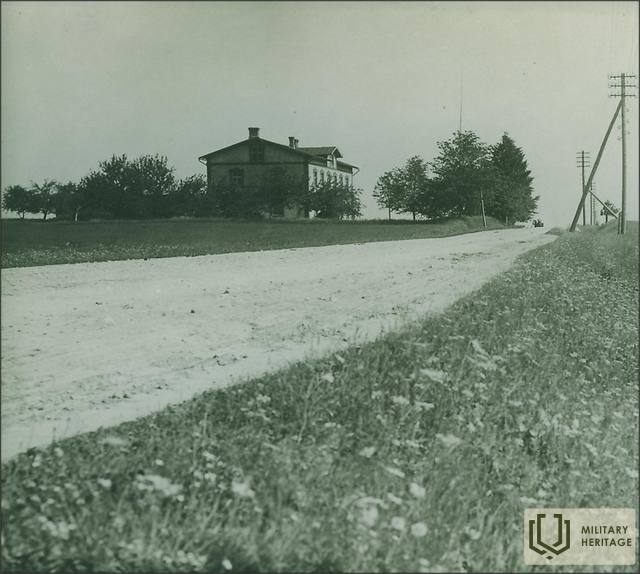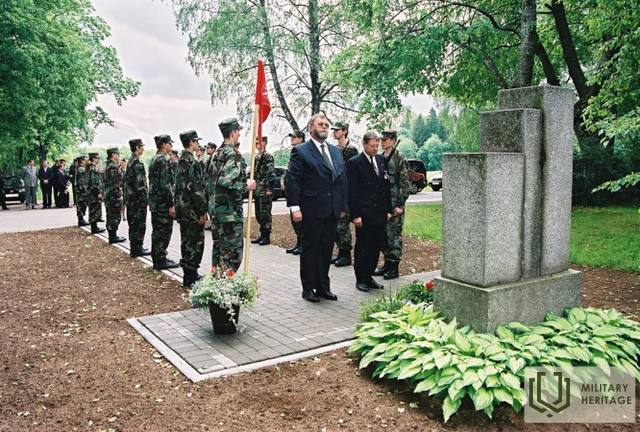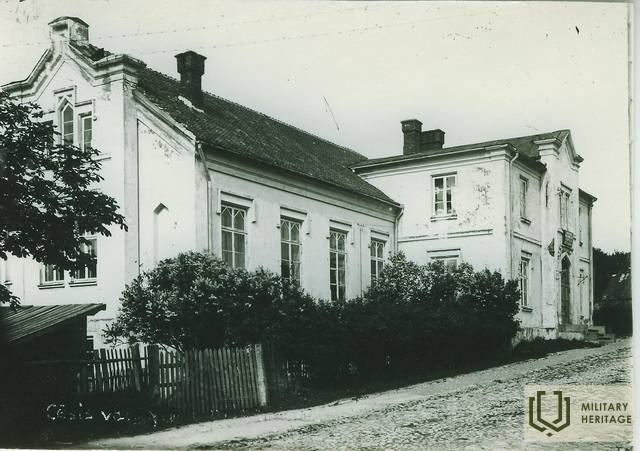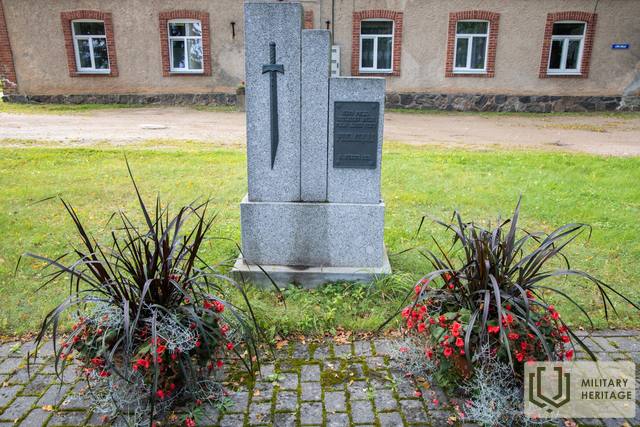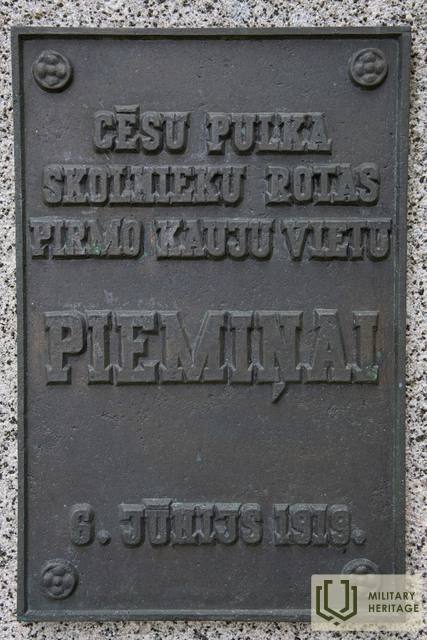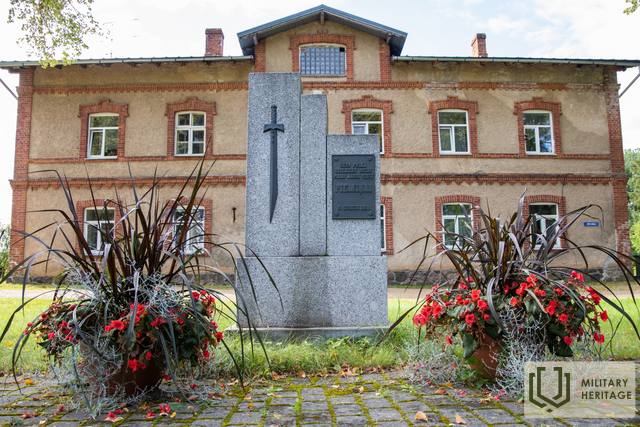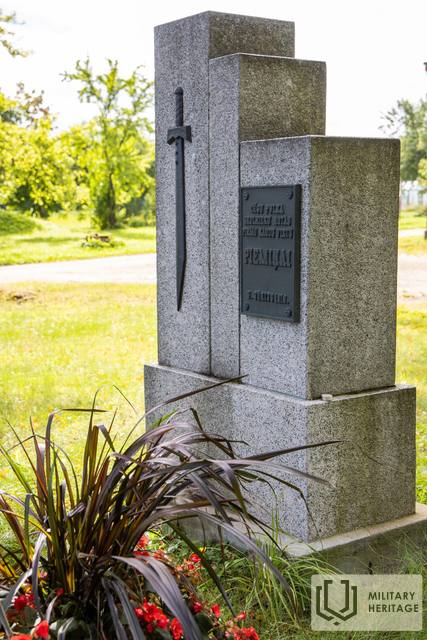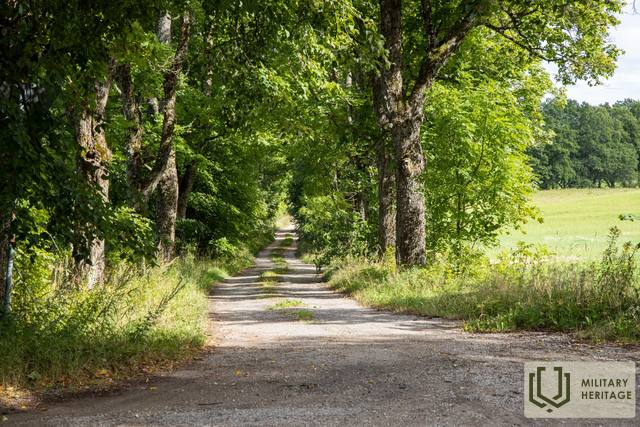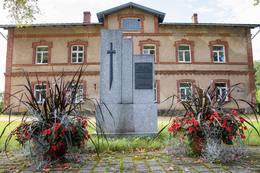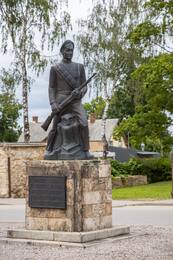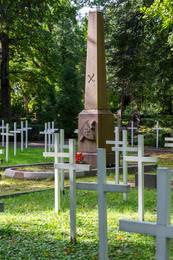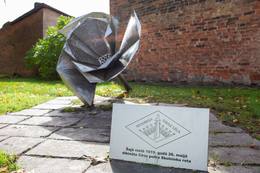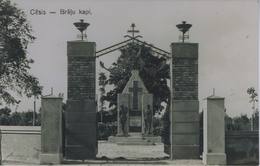The monument dedicated to the Cēsis Regiment student detachment near the former Livu Parish Hall
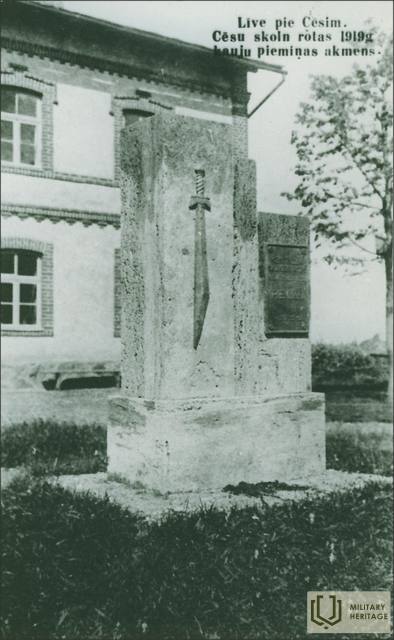
The Cēsis Regiment volunteer schoolboy company participated in the 1919 Cēsis battles, which formed as a combat unit from 108 young people from Valmiera and Cēsis schools on June 5 in the premises of the Cēsis Progymnasium. Already on the night of June 5 to 6, about an hour after midnight, there was an alarm and the company was ordered to move to positions. The company moved to the Mācītājmuiža - Meijermuiža line, which was considered the most important battle area.
In the first battle, several schoolchildren were wounded, but Edgars Krieviņš, a Valmiera native, died on the same day from a very serious wound to the stomach. He was buried with military honors at the Valmiera City Cemetery on June 13. Edgars Krieviņš was posthumously awarded the Lāčplēsis War Order.
In 1929, when the 10th anniversary of the Battle of Cēsis came, former soldiers of the student company founded the “Cēsis Regiment Former Volunteer Student Company Soldiers' Association”, which in the following years took care of preserving the memory of this military unit and popularizing it among school youth.
Already in 1930, a monument was erected on the side of the Cēsis-Āraiši highway near the Līvu parish house, marking the place of the company's first battle. The author of the project was the former soldier of the company, architect Kārlis Dzirkalis (1902 – 1997), but the author of the bronze relief was sculptor Matīss Pluka (1893-?)
K.Dzirkalis. Ideological explanation of the memorial stone near the Livu parish house.
“First of all, the three honeycombs placed next to each other resemble a line of soldiers, that is, images of soldiers standing in a row, arranged in order of size. The greatest direct merits in the liberation of Latvia also went to the soldiers.
Secondly, these stones express the cornerstones and foundation stones of our country's struggle on which our victory was based at that time. They are -1.- the vigor and sharpness of the soldiers' spears, 2.- the tense spirit of spirituality and enthusiasm, and 3.- the broad love of the fatherland.
Thirdly, the memorial stone indicates the creation and formation of our national idea. Stone 1. - the birth and awakening of a pronounced national consciousness, when Latvian thoughts and deeds had to be sharp in order to prove their life abilities (Kr. Valdemārs, Rainis, etc.). Stone 2. indicates in its own way the narrowing of the nation during the war and refugees, misery and worries. The third stone means the current young generation, on whose shoulders with weapons in their hands they won freedom. The latter is therefore stable and firm. On it will also be a mark in the form of a plaque about the beginning of the great and last battle that took place. As is known, the first signal and shot took place near the Livu parish house, where the battle began between the schoolboy company and the Manteufel cavalry division.” (LVVA 1967.fonds, 1.Apr., 17.lieta, 8.p.)
Source:
The sun rose from the sword. A collection of memories and documents about the Cēsis Regiment's Pupils' Company in 1919. Compiled by Tālis Pumpuriņš. – Cēsis, Cēsis Museum Association, 1994.
About the demolition and restoration of the monument - J. Lismanis' book "In Memory of Battles and Fallen Soldiers 1915–1920"
Related timeline
Related objects
Monument at the site of the Battle of the Schoolchildren's Company
On the side of the Cēsis-Āraiši highway, near the former Livu parish house.
A monument dedicated to the volunteer student company of the Cēsis Regiment, which participated in the Battle of Cēsis in 1919, can be seen.
The monument was unveiled on May 29, 1930, near the former Livu parish house.
The monument project was developed by former student volunteer K. Dzirkalis, and the installation work was carried out by A. Sproģis' company in Cēsis.
The bronze details were made by M. Pluka according to the author's drawing, and they were cast at the V. Minūtas factory in Riga. After World War II, the monument was destroyed.
Restored on June 6, 1989, the authors of the restored monument were sculptors A. Jansons and M. Baltiņa, and architect I. Timermanis.
Later, the bronze sword and plaque were removed for safety reasons, replaced with wooden parts.
Monument for students of the Cēsis Regiment
The monument to the soldiers of the Cēsis Regiment Students’ Company who died in the Battles of Cēsis is located in the city of Cēsis, near the intersection of Palasta and Bērzaines streets. The construction of the monument was proposed by the Soldiers’ Association of the Cēsis Regiment Students’ Company. The monument was unveiled on 26 May 1938. The monument is based on the idea sketched by artist Jānis Rozenbergs, a former soldier of the company. Placed on a metre-high limestone pedestal, the 1.8-metre copper sculpture of a soldier dressed in a school student’s uniform was created by sculptor Rūdolfs Āboltiņš and coppersmith Jānis Zibens. An owl, a symbol of wisdom and knowledge, lies at the soldier’s feet, squatting on and protecting the books of a student who went to war. The sculpture was demolished during the Soviet re-occupation in 1952. A monument named the Komsomol Flag Bearer by sculptor Kārlis Jansons was erected near its former location in 1957. Placed near its historic site, the restored monument was unveiled on 11 November 1992. At the same time, in 1992, a monument to the Komsomol, which had been erected by the occupation regime, was taken down.
The cemetery of the brothers of the Latvian riflemen who fell in World War I and the soldiers who fell in the War of Independence
Located in the Valmiera City (Center) Cemetery, Lillijas Street 7.
A granite obelisk can be seen, the details of which were forged by sculptor Wilhelm Trey.
The monument was unveiled on June 22, 1923. About 150 soldiers are buried in the fraternal cemetery.
Several fighters of the First World War and the War of Independence are buried in the city cemetery, including the first casualty of the Cēsis Regiment's School Company, LKOK Edgars Krieviņš.
Currently, the section of the fraternal cemetery contains 14 groups of graves of various lengths, on which 139 white wooden crosses have been installed, but the plaques with the names of the fallen, which used to be on the crosses, are no longer there. One black granite cross has survived.
During the communist occupation, intensive civilian burials were carried out in the section of the fraternal cemetery. After the restoration of independence in 1994, the burial layout in the fraternal cemetery was changed, and the grave groups are now arranged crosswise, with only one retaining its former orientation.
Memorial sign at the site of the founding of the Cēsis Regiment's Student Company
Located at Leona Paegles Street 1, near the facade of a red brick building.
The author of the memorial is artist Solveiga Vasiļjeva, and the idea is based on the motif of a flower bud. As the artist points out, it symbolizes personalities that have just begun to form – students who must make an important, responsible and tough decision in their still short lives.
In the form of the memorial, the outer petals of the flower bud are designed geometric, with sharp corners, in contrast with the soft, rounded ones inside the bud. The height of the memorial is up to 1.5m. The memorial was unveiled on May 26, 2011 in Valmiera, at the place where the Cēsis Regiment cadet company was formed in 1919.
The outlines of Latvia are laid out from artificial paving stones, on which a plaque with the flag of the Cēsis Regiment's Pupils' Company and the text is placed lying down:
"In this place on May 26, 1919
"Cēsis Regiment School Company" was founded
Cēsis Brothers' Cemetery
Located in the Cēsis Lower Cemetery, Lenču Street 15, Cēsis.
One of the most significant memorial sites of the First World War and the War of Independence in Cēsis is the Brothers' Cemetery in Lejas Kapis.
The cemetery houses the Brothers' Cemetery Monument, designed by Cēsis artist and councilor Augusts Julla (1872-1958), unveiled in 1927, and dedicated to the soldiers buried in the Brothers' Cemetery from 1915 to 1920.
About 200 soldiers are buried in the Brothers' Graves of the Cēsis Leja Cemetery. Among them are an unknown number of Latvian riflemen and Russian soldiers who fell in World War I, as well as soldiers of German (10), Polish and other nationalities. During the Latvian Liberation Struggles, 22 soldiers of the 5th (2nd) Cēsis Infantry Regiment were buried in this cemetery, as well as 11 freedom fighters who fell in other Latvian army units. 2 Estonians, 15 victims of the Bolsheviks, and Latvian Red Riflemen also rest in the Brothers' Graves.




